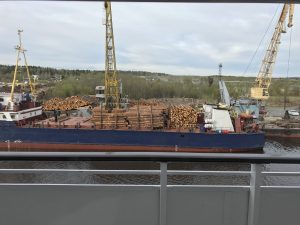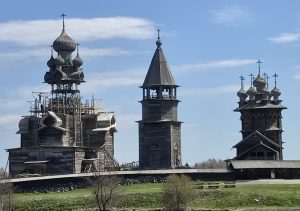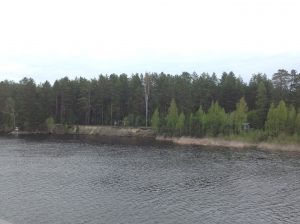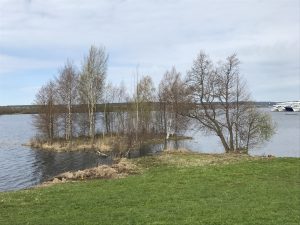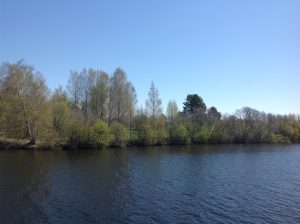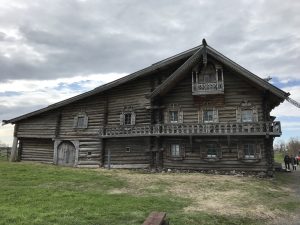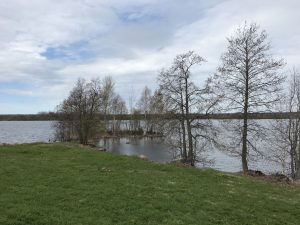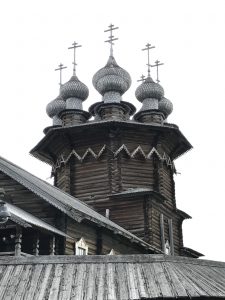Imperial Waterways of Russia
Monday, June 5
Kizhi Island
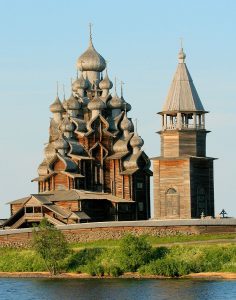 I guess I was more excited about this day’s shore excursion than I had been about anything else leading up to this cruise. In fact I spent a lot of time returning to brochures and websites before we left, just to look at photographs of the Church of the Transfiguration on the Island. That’s only one of the two churches there; check out the UNESCO website to read about the Kizhi Pogost if you want some details. It’s truly worth a visit if you get the chance to do so. This photo is from Wikipedia, and you can see why it attracted my attention. After all, how many chances in my life would I have to see a wooden church, built without nails, that had 22 cupolas on top of it?
I guess I was more excited about this day’s shore excursion than I had been about anything else leading up to this cruise. In fact I spent a lot of time returning to brochures and websites before we left, just to look at photographs of the Church of the Transfiguration on the Island. That’s only one of the two churches there; check out the UNESCO website to read about the Kizhi Pogost if you want some details. It’s truly worth a visit if you get the chance to do so. This photo is from Wikipedia, and you can see why it attracted my attention. After all, how many chances in my life would I have to see a wooden church, built without nails, that had 22 cupolas on top of it?
Did I mention this was the northern-most part of the cruise, above the 62nd parallel. Or that it’s about on a level with Anchorage, Alaska? In addition to all the wooden buildings that are part of the outdoor museum, there is also a village on the island, where about 60 people live year round. Really. The summer highs are above freezing, and we were there on a windy and sunny day when the high was at least a little above 40°. The winter temperatures are something I don’t want to contemplate.
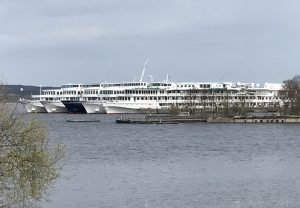 Of course, I’m fairly sure that every cruise ship on the Neva, Svir and Volga rivers makes a stop there. It was a bit crowded at the dock when we arrived, so we had to walk through three other ships just to step onto the island itself. This was one of the days when Judy and I decided to join the ‘slow walking group’ from the River Victoria, so we didn’t get to see all the buildings. The whole island isn’t part of the UNESCO site, but there are almost 90 buildings included here in the Museum of Wooden Architecture. Our group would concentrate on only a few of them, but that was OK with us.
Of course, I’m fairly sure that every cruise ship on the Neva, Svir and Volga rivers makes a stop there. It was a bit crowded at the dock when we arrived, so we had to walk through three other ships just to step onto the island itself. This was one of the days when Judy and I decided to join the ‘slow walking group’ from the River Victoria, so we didn’t get to see all the buildings. The whole island isn’t part of the UNESCO site, but there are almost 90 buildings included here in the Museum of Wooden Architecture. Our group would concentrate on only a few of them, but that was OK with us.
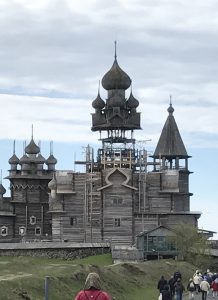 There was one serious disappointment that our Cruise Directors had told us about ahead of time. The large Church of the Transfiguration is being restored, with rotten boards being replaced and new birch shingles being hand cut to recover the cupolas. The work started at the bottom of the structure, and this year they’re working on the middle of the building. Believe it or not, that means the lower third of the building looks new, the top third looks like it does in the photograph above, and the middle third is just missing. Seriously. The top portion is held up by some skinny-looking scaffolding, and the top looks like it’s just floating in thin air. it’s sort of a cool sight, but not quite so awe-inspiring as the whole thing must be.
There was one serious disappointment that our Cruise Directors had told us about ahead of time. The large Church of the Transfiguration is being restored, with rotten boards being replaced and new birch shingles being hand cut to recover the cupolas. The work started at the bottom of the structure, and this year they’re working on the middle of the building. Believe it or not, that means the lower third of the building looks new, the top third looks like it does in the photograph above, and the middle third is just missing. Seriously. The top portion is held up by some skinny-looking scaffolding, and the top looks like it’s just floating in thin air. it’s sort of a cool sight, but not quite so awe-inspiring as the whole thing must be.
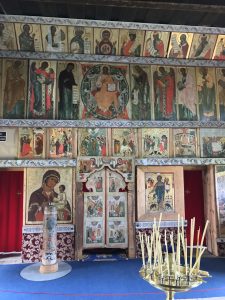 We did get to go inside the smaller church inside the fence: The Church of the Intercession. It was hard not to draw a comparison between this church and the Church on the Spilled Blood we had seen in St. Petersburg. They were completely alike in one way, because the icons and images were all there, the iconostasis was where it should be, and they are both used for the same type of religious services. But the appearance couldn’t have been a bigger contrast. This was a rustic wooden building about 200 years older than the Spilled Blood church, One interesting thing I hadn’t thought to see there: birch twigs, or maybe small saplings. There were two of them, and it turns out they are part of the traditional Trinity Service, which had been the day before.
We did get to go inside the smaller church inside the fence: The Church of the Intercession. It was hard not to draw a comparison between this church and the Church on the Spilled Blood we had seen in St. Petersburg. They were completely alike in one way, because the icons and images were all there, the iconostasis was where it should be, and they are both used for the same type of religious services. But the appearance couldn’t have been a bigger contrast. This was a rustic wooden building about 200 years older than the Spilled Blood church, One interesting thing I hadn’t thought to see there: birch twigs, or maybe small saplings. There were two of them, and it turns out they are part of the traditional Trinity Service, which had been the day before.
 We also got to see a nineteenth-century farmer’s house, moved here as one of the first buildings in the Museum. Its architecture is right for a place that sees four- to six-foot snowfall for several months a year, and that’s a little different from the kind of nineteenth-century building I grew up around. But it was really interesting to see how many familiar things were inside. The woven wooden baskets were made of birch instead of water oak, but the technique is the same as the cotton baskets I remember from my childhood.
We also got to see a nineteenth-century farmer’s house, moved here as one of the first buildings in the Museum. Its architecture is right for a place that sees four- to six-foot snowfall for several months a year, and that’s a little different from the kind of nineteenth-century building I grew up around. But it was really interesting to see how many familiar things were inside. The woven wooden baskets were made of birch instead of water oak, but the technique is the same as the cotton baskets I remember from my childhood.
 The afternoon was spent cruising back down Lake Onega and into the Volga-Baltic Canal, moving past birch forests and stack after stack of birch logs ready to be shipped along the same river we were on. We enjoyed the daily history talk, as we always did, and that was followed by a “tea-time” demonstration on making blinis. I might not have volunteered to drink vodka in front of the group, but I jumped right up to cook a crepe. That was something I could actually do!
The afternoon was spent cruising back down Lake Onega and into the Volga-Baltic Canal, moving past birch forests and stack after stack of birch logs ready to be shipped along the same river we were on. We enjoyed the daily history talk, as we always did, and that was followed by a “tea-time” demonstration on making blinis. I might not have volunteered to drink vodka in front of the group, but I jumped right up to cook a crepe. That was something I could actually do!
Dinner was fun again, with the couples who were now our regular evening companions. All in all this was a great day, in spite of the suspended flying cupolas on top of the Transfiguration.


